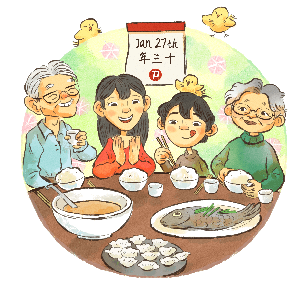As many as 12 countries celebrate Lunar New Year’s Eve
January 27th, 2017

Illustration Artist:Janice Liu
Food is a large part of Lunar New Year, especially dishes made on New Year’s Eve- they are chosen for the significance of their names.
New Year’s Eve is the time when family members, even those living far away would come back to get together. Thus, the dishes generally represent fortune and well-being for the family.
China
In Chinese culture, fish stands for an abundant year (Fish in Chinese sounds similar to the word “surplus”) while dumplings stand for wealth as they look like gold ingots in the past.
Japan
Families in Japan celebrate Lunar New Year’s Eve by having buckwheat noodles called soba, which symbolizes longevity.
Korea
Lunar New Year is also called Seollal in Korean. The two signature dishes are sliced rice cakes cooked in soup called Tteokguk and dumpling soup called Mandutguk. Both dishes symbolize longevity, good health and good luck in the coming year.
Singapore
In Singapore, people celebrate Lunar New Year’s Eve with a dish called Lo Hei Yee Sang. This dish includes 7 ingredients, such as fish, carrots, cucumber, radish, spring onion, peanut crumbs and so on. The dinner usually starts with everyone standing around the table, mixing all the ingredients while saying “Lo Hei”, which symbolizes turning to a good year.
Vietnam
In vietnamese culture, food is an important element of the Lunar New Year celebration (Lunar New Year Celebration is also called An Tet in Vietnamese, which translates to eat during the New Year in English). Prior to the new year, families would cook specialty food such as pork belly with coconut juice and sticky rice dumplings with meat fillings.These dishes symbolize a peaceful year ahead.
There are more varieties to Lunar New Year's Eve dishes, click here to see how many dishes you know about!



